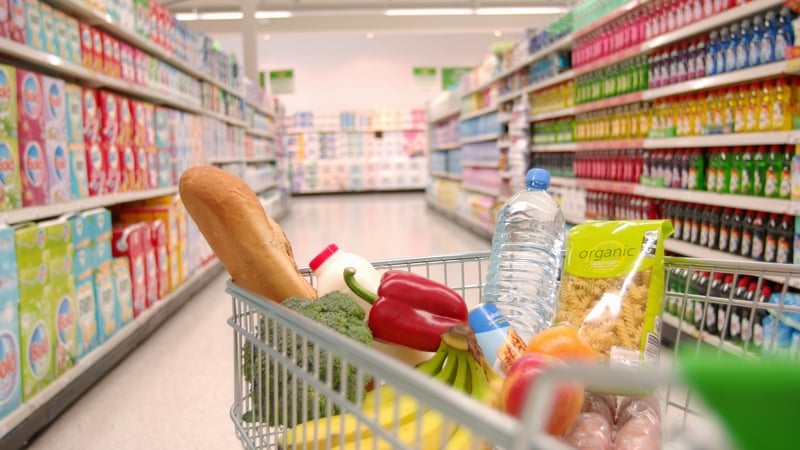As of right now, we still don’t know exactly what tariffs will be applied by the US. And whatever is applied, it won’t really have an impact on what Irish consumers pay at the till – not directly, anyway.
But what the US tariffs will likely do is shape the European Commission’s response, and influence tariffs that it might decide to impose on US imports. And these are the tariffs that will ultimately have an impact on Irish consumers.
So while there are lots of known unknowns, ifs and buts at the moment, it is possible to get some picture of how tariffs could impact consumers here.
So where might we see an impact?
We do have some clues as to what Europe might do in the coming weeks or months – because last month, when the US imposed steel and aluminium tariffs on the EU, the European Commission responded by reintroducing suspended steel and aluminium tariffs of its own.
But it also outlined a new package of tariffs that it was planning to impose from the middle of April onwards. There is a chance that what it announces tomorrow will build on that – so the scope could widen again – but for now it’s what we have to work with.
And included in there were proposed tariffs targeting the likes of American-made appliances, vehicles, tools, and day to day products like meat, dairy, nuts and vegetables.
Would we have much to worry about with meat and dairy tariffs?

Probably not. The US a major exporter of meat and dairy – across beef, pork and poultry it had around $15 billion in exports in 2023, dairy exports were worth around $6.6 billion in the same year.
But not much of that ends up here in Ireland. Most of the meat and dairy that’s on our shelves is Irish; some of it is British, some of it might come from mainland Europe. But very little – if any – is coming from the US.
China is actually the biggest importer of American meat – Mexico and Canada are the biggest dairy importers. (which, by the way, might actually represent somewhat of an opportunity for Irish producers impacted by US import tariffs).
So what about nuts and vegetables?

It’s a different story here – because we of course don’t have much of a nut industry here in Ireland. But the US is a major exporter of edible nuts globally – particularly tree nuts like almonds, pistachios and walnuts.
The US accounts for more than half of the world’s almond exports each year. In 2023 it exported more than 678m kilos of shelled almonds, which is about seven times the next biggest exporter, Spain.
It’s a similar story with pistachios – it had about ten times the volume of exports there in 2023 than the next biggest seller, which was Turkey.
It wasn’t actually the world’s biggest exporter of walnuts – it had about half the quantity as China – but it did have the highest value exports, which shows that it is commanding a much bigger premium on its products than others.
But altogether that means that US supply of these products is very important to the global market. Even if the almonds or pistachios you’re buying aren’t from America, the price you pay for them is hugely influenced by what the US selling its stock for.
And while there are clearly other countries that we can get these products from – they aren’t producing at even nearly the same level, so that means that we’re likely to see prices rise considerably, and potentially supply fall, if tariffs are imposed here.
That’s also true of soybeans – which is actually the biggest US agricultural export by value. Most of that is going to China (getting them to buy more soybeans was part of Donald Trump’s deal making during his first term).
And even if you’re not a big fan of soybeans, their price is important in other ways because they’re often used as animal feed, in biofuels and in some cooking oils.
A tariff on vegetables could also potentially expose us to higher prices in the likes of avocados, sweet potatoes and oranges. Other countries like Mexico, the Netherlands and Spain are big suppliers in these product categories too, but the US plays a big part in global trade. And, again, if their prices are pushed up it reduces options for buyers and likely makes the end product more expensive for the consumer.
What about appliances and vehicles?

This is where things may start to get tricky, because there are plenty of American appliance and vehicle brands – but that doesn’t necessarily mean their products will have tariffs applied.
Harley Davidson is often an example given because their motorbikes are assembled in the US – and heavily reliant on US parts. So they would be subject to any tariffs that the EU imposes.
However Ford is also an American vehicle manufacturer, but it’s probably not as worried about the trade row between the US and EU, because it also manufactures cars on the continent. That means its vehicles would get around most or all of the tariffs that are imposed.
And it’s a similar story for a lot of appliance brands – like KitchenAid, Whirlpool and Hoover.
They’re all American brands and they do a lot of their manufacturing in the US – but they also have factories in Europe, and other parts of the world with low or no tariffs with the EU. So their products may not be impacted much at all.
What it may require is some reworking of their supply chains – which could take time and add costs. And they may also be impacted in less obvious ways, for example, if some of their parts or raw materials are crossing the Atlantic, then those components could be subject to tariffs. That would either add to their costs or force them to find alternatives… and that will ultimately that will impact the end consumer.
What about drinks?

Again, when you think about some of the all-American drinks brands – the likes of Coca-Cola or Budweiser – they may be American brands but the drinks on the shelves here were made in Europe. So they likely won’t be impacted at all.
Where EU tariffs could add to costs for consumer is in US products that are tied to a specific location. Like wine, for example.
There’s a lot of Californian wine on the shelves of Irish shops and off licences and that would very much be impacted by any tariff on alcoholic drinks, which have also been mooted by the European Commission.
Again, we have plenty of alternative options available – from Europe, South America, Australia and so on – but if you are specifically a fan of wine from the likes of California, you’re going to see prices rise and possibly face more limited supply too.
There are some US-based craft beer brands that make all of their products on home soil – like Sierra Nevada and Boston Brewing – they can currently be found in some off licences here, but that will likely change when tariffs kick in.
The same goes for Bourbon – which is legally required to be made on US soil. The EU had suggested it would add a 50% tariff on bourbon – which would probably price most of the makers out of the European market. Again, we have alternatives like Irish whiskey, Scotch and Japanese whiskey, but if you specifically like bourbon you’re looking at significant price increases and reduced supply.
There is an interesting potential side effect on Irish whiskey here, too. A lot of Irish whiskey producers use bourbon casks for the maturation of their drinks, because of the flavour it imparts on their drink. But the commission has suggested a tariff on the import of wood products from the US, which presumably would include spent bourbon casks.
So that could make them more expensive, or even too expensive, for producers here to import. If so, that might force them to tweak their process and flavours, and be more reliant on the likes of European sherry producers for their casks.
And it’s this kind of thing that could, ultimately have the biggest effect on Irish consumers.
What do you mean?
Well along with specific categories of food and appliances, the commission has also proposed tariffs on wood products and plastics, as well as steel and aluminium tariffs that have already been reintroduced.
And if you look at the value of imports from the US to Ireland last year, you see the most valuable areas are at the commercial end – the likes of electrical machinery, power generating machines, scientific equipment and so on.
So even if your shopping trolleys isn’t full of American-made goods, a lot of the companies that make the products that are in your trolley are probably somewhat or entirely reliant on American-made machines – or on American raw materials like wood, plastic and steel.
And so the tariffs there would make the manufacturing, purchase and maintenance of their equipment more expensive – which in turn would make the goods they produce more expensive.
Is there any chance this could make some goods cheaper for Irish consumers?

Possibly, but it’s unlikely to last long.
If Donald Trump does what he’s been signalling and introduces tariffs across the board on goods from the EU – then it would obviously make Irish goods less competitive in that market.
And if they’ve been producing products under the assumption that they can sell it in the US, and then suddenly that market is all but closed off to them, they could end up with a surplus of goods that they have to sell off. Potentially, that might force them to reduce prices here in order to shift the goods.
Irish dairy – specifically butter and cheese – is very popular in the US: whiskey is a big seller there too.
Realistically, though, if there is any deflationary effect it will be very limited and very short – because most manufacturers have probably been stockpiling their goods in the US in advance of tariffs kicking in, so that they avoid the higher charges for as long as possible. In the meantime they’ll be either trying to ramp up their sales in other markets, or adjusting their production levels to match the falling demand, or both. And that’s with the aim of trying to ensure they don’t have too many products with no prospective buyer.
And it’s at this point, unfortunately, where we could start seeing jobs being lost as manufacturers and their factories start to scale back.




